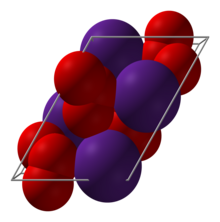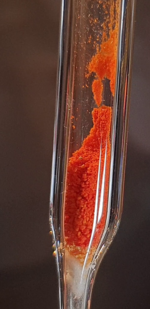Caesium ozonide
 Caesium cations, Cs+ Ozonide anions, O−3 | |
 Caesium ozonide contaminated with caesium superoxide
| |
| Names | |
|---|---|
| IUPAC name
Caesium ozonide
| |
| Identifiers | |
3D model (
JSmol ) |
|
| |
| |
| Properties | |
| CsO3 | |
| Molar mass | 180.902 g·mol−1 |
| Appearance | Dark cherry red powder[1] |
| Density | 3.19 g/cm3[1] |
| Melting point | 85 °C (185 °F; 358 K) (decomposes) |
| Related compounds | |
Other anions
|
|
Other cations
|
|
Except where otherwise noted, data are given for materials in their standard state (at 25 °C [77 °F], 100 kPa).
| |
Caesium ozonide is an
- CsO2 + O3 → CsO3 + O2
The compound reacts strongly with any water in the air forming caesium hydroxide.[3]
- 4 CsO3 + 2 H2O → 4 CsOH + 5 O2
If heated to between 70 and 100 °C, caesium ozonide will quickly decompose to caesium superoxide (CsO2).metastable to decomposition into caesium superoxide, slowly decomposing at room temperature, but can remain intact for months if stored at −20 °C.[4]
Above around 8 °C, the crystal structure is of the caesium chloride type, with the ozonide ion in place of the chloride ion. At lower temperatures, the crystal structure changes to a structure identical to rubidium ozonide (RbO3), with space group P21/c.[2]
References
